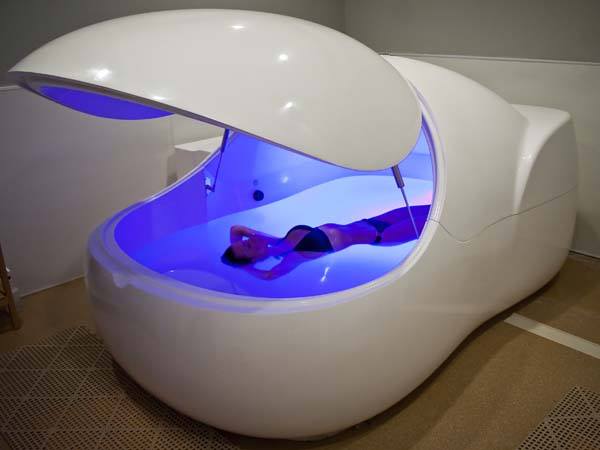How I tried a float tank and experienced the ultimate form of relaxation.
My expectations were low as the automatic lid slowly lowered and latched shut on the tank. My body was floating on the Epsom salt and water mix and a blue glow surrounded me. I hit the button next to me and was immersed in total darkness. I felt like Spock about to be launched from the Enterprise for a proper Federation burial in space. The water settled around me and I was suspended on what felt like nothing. “So what if it is bullshit, just trying will make for a cool story,” I thought to myself and without noticing, ninety minutes had passed and a soothing bit of Radiohead reverberated through the water and brought me back to Earth. My more experienced friend had told me before floating that afterwards is like “seeing the world in HD,” but it wasn’t until I stepped out of the tank that I realized what he meant. I was focused but relaxed; everything was clear and it was like going straight from VHS to Blu-ray. Obviously I was skeptical at first, but after my first float I realized that float tanks in fact are not bullshit and after further research I’m even more convinced. Floating is a rather straightforward process, but before your first float it’s beneficial to know some float tank tips, what happens on your first visit, and a little science on the benefits of floating.
TEN TIPS
If you’re interested in how to achieve the most during your first float, check out these ten tips:
- Make sure a towel is easily accessible from within the tank because you will get salt in your eyes. There is nothing worse than scratching an annoying itch on your face only to get burning salt water in your eyes!
- Do not drink anything for at least two hours and try to use the bathroom before using a float tank. You do not want a full bladder ripping you away from “the zone,” so make sure to go in empty.
- Do not think about time. Worrying your session is about to end or wondering how long you’ve been in only subtracts from the experience. The music that plays at the end of your session is sure to take you out of “the zone”.
- If after your first float you think you had trouble worrying about time, try requesting for the float center to play music for the first half and silence for the second half of your next float. Music is a good experience to try while floating, and the half music, half silence method works as a timer to let you know when your float is half over so you can focus less on time and more on the float.
- Focus on breathing. Just like meditation, focusing on breathing really helped me relax.
- Try to schedule your first float to last at least one and a half hours and get out and take a break if you need it. The more times you float, the less time you need to get in “the zone” during future floats, so don’t let the hour and a half scare you.
- Floating for the first time will not be anything like you can imagine. That’s okay, because it’s impossible to go in with no expectations. Just remember, one thing you can expect for sure is that you will leave the tank feeling relaxed.
- Use waterproof Band Aids to cover cuts. Ever heard the idiom “to rub salt in a wound?” Because of the salt in the tank, forgetting to cover cuts brings that idiom to life in a float tank.
- Try floating both with and without the foam pillow. I prefer not using the pillow but others find neck support helps relaxation.
- If the smell of chlorine bothers you, try looking for a float center that doesn’t use it. I prefer floating without chlorine, but honestly floating is awesome enough with or without.
THE PROCESS
I was pleasantly surprised when I walked through the door to the float center. The room smelled like sandalwood and a Himalayan salt lamp glowed softly in the corner. Bamboo plants and tapestries accented the room as a tiny waterfall filled the room with a soothing trickle. This was not what I had expected. When I thought of a “float tank center,” an image of the stasis chambers in the movie Alien came to mind. Clearly that was not the case. As I approached the counter, I was greeted by the receptionist and then was given a rundown on the entire floating procedure. After signing my life away, the receptionist guided me through the process of floating.
She explained that before and after using the float tank, I needed to shower to ensure the water in the tank would remain as clean as possible for the next person since the water isn’t changed after every float. Most float tanks are equipped with filtration devices but the mix does need to be changed every now and then. The receptionist then told me how to use the tank. There are different kinds of tanks, but the ones at this center had two buttons inside: one used to toggle a soft blue light inside the tank, and another that operated the lid and heater in case the tank was too cold. She told me I could use the foam pillow in the float room to support my neck and that I should wear the earplugs provided to keep the salt mix out of my ears. The earplugs also have the added bonus of an even quieter float. A spray bottle of fresh water and a towel was hanging on the inside of the float tank in case I got salt water in my eyes.
I followed her back to my float room (a happy ending was not given), which contained the tank and a small bathroom. Each person gets their own room and bathroom for privacy. Another salt lamp and the blue glow coming from inside of the open tank lit the room. She explained to me that all I needed to do was to get in and relax. I was worried about floating around but she assured me that by staying still, my body would naturally float to the center of the tank because the heaters lining the bottom of the tank caused an unnoticeable current to hold the person in the center. After the session was up music would play and the lid would glide open to let me know my time was finished.
Are you looking for a Floatation Tank in Melbourne? Check here: Floatation Tank Melbourne Sensory Deprivation Float Tank.
THE SCIENCE
Not unlike meditation, floating helps reduce stress and float tanks may be the ultimate form of healthy relaxation. The water is calm and heated to body temperature in order to prevent any physical sensations (except the occasional itch). The tank provides complete darkness and silence. Some float centers use chlorine to treat the water, but it’s best to avoid tanks with chlorine to get the full sensory deprivation experience. Without the five senses to distract you, in a float tank it’s just you and your mind.
After floating for the first time, I decided to do some research on the science behind floating to decide if the feeling during and after floating is purely placebo or if it does in fact have real health benefits. Pleasingly, I have found that the later is true. Research shows float tanks not only reduce stress by helping the body reduce cortisol levels but also allow the body to absorb magnesium, which can improve feelings of fatigue. If you’re familiar with Fix Your Gut, then you’ve probably come across one of John’s top blog series about the importance of magnesium.
As I’ve said before, float tanks use a mix of water and Epsom salt, which is also known as magnesium sulfate. This was originally used to provide more buoyancy to allow the person to float high enough to still be able to breath. Now, research shows that while floating, the body actually absorbs magnesium through the skin. 1 Magnesium deficiency is associated with feelings of fatigue, so after absorbing a healthy amount of magnesium during a float session, the body feels refreshed.
Floating not only helps with fatigue but can also reduce stress levels. While floating the brain can experience twenty-minute or longer periods of being in a theta state, which is the same state the brain is in while daydreaming and the moments before falling asleep and shortly after waking up. 2 It’s difficult to describe how to “go into the zone” and truly relax while floating or what that even means, but if you just relax your mind will do the rest and the boundaries of your body will fade away. To me, being in “the zone” was more like how I feel right as I begin to drift off to sleep; a dreamlike but still conscious state. This purely relaxed state helps the body lower cortisol levels and reduce stress. Watch this Joe Rogan video about floating to help you grasp what I mean by “the zone”.
FINAL THOUGHTS
Float tanks are unlike anything I’ve ever experienced before. It’s something you have to experience yourself to truly understand, but if you’re wanting more before floating, watch this Vice documentary about float tanks. I’ve floated several times again after that first float and speaking from experience it only gets better each time. So, what are you waiting for? Find a float center near you and experience the ultimate form of healthy relaxation. Leave a comment below to share your experience or ask any questions to help make your first float the best possible.
- Dr R H Waring, 2004, Report on the absorption of magnesium sulfate (Epsom salts) across the skin, School of bio-sciences, Univ of Birmingham B15 2TT, UK , ↩
- Talley, Graham. “About Floating Guide”. About Floating Guide.. Float Tank Solutions. Retrieved 9 March 2013. ↩
- “Restricting environmental stimulation influences levels and variability of plasma cortisol”. Float Tank Association. Retrieved May 15, 2013.
Source: Fixyourgut.com








Leave A Comment